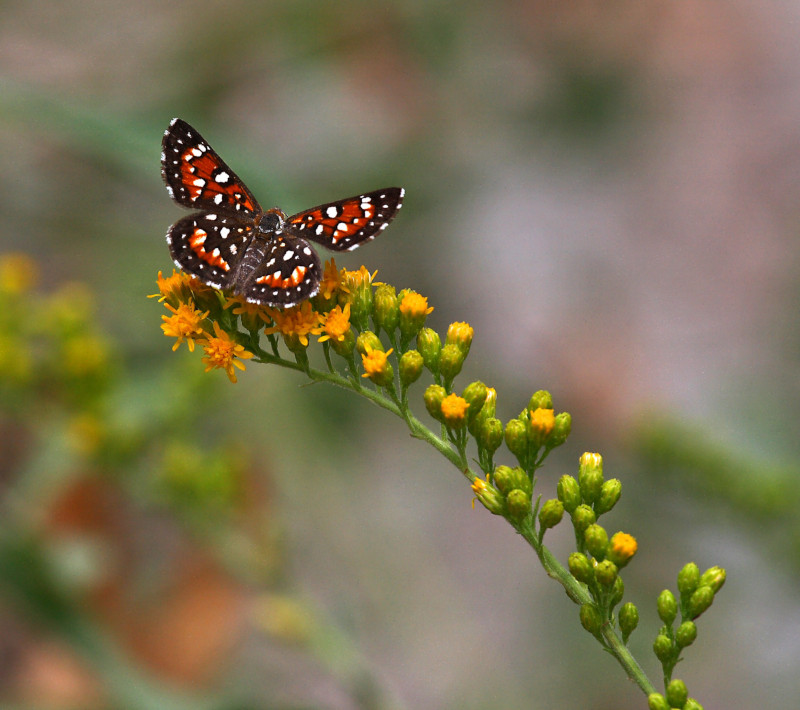Mormon Metalmark Facts
- The unique term of Mormon Metalmark serves as the common name for a stunning small Lepidoptera. Its scientific name, however, remains harder to pronounce. That’s because scientists known the species by the term of Apodemia mormo.
- Regardless of which term one uses, though, one statistic stands out. That’s the simple fact that it’s the widest ranging of any member of its Family in its region. All members of that group are referred to as metalmarks, due to a distinctive feature.
- The first scientific recognition of the creature as a separate and distinct species occurred in 1859. Uniquely, though, this took place as a result of the combined work of a father and son team. The two men were Baron Cajetan von Felder, and his son Rudolf.
- For the moment, the IUCN has no listing of the Mormon Metalmark on its Red List of Threatened Species. The insect nevertheless faces numerous potential threats to its existence. These include such factors as isolated distribution and low genetic diversity.
- Its greatest threat, however, comes from the same danger facing a vast number of species today. That peril, not surprisingly, consists of the effects of climate change. The other dangers it faces only serve to augment its susceptibility to the former.
Related Articles
Mormon Metalmark Physical Description
The magnificent Mormon Metalmark ably proves the point that Beauty in Nature comes in all sizes, as well as shapes. That’s true since this particular Lepidoptera evolved as relatively tiny in size. This is a trait shared by many members of its Family, in point of fact.
The amazing arthropod also shares yet another trait with many of its kin throughout the world. It displays a small degree of the physiological characteristic of sexual dimorphism. In its case, this actually manifests itself in two completely different manners.
The first of these gender differences appears in terms of size. More precisely, females tend to attain a slightly greater wingspan than males. Overall, however, the species remains quite diminutive. That’s because this averages between 1.0 -1.35 in (25 – 35 mm).
Next, however, comes the other sexually based physical variations. It’s also a highly distinctive one. The females actually have more functional legs than males! They have three functioning pairs of legs. Males, meanwhile, make do with only two working pairs.
In appearance, though, the Mormon Metalmark varies across its range. That’s because of variations developed among widely scattered population concentrations. Some display combinations of gray and brown, with white spots. Others present red and orange shades.
- Kingdom: Animalia
- Phylum: Arthropoda
- Class: Insecta
- Order: Lepidoptera
- Family: Riodinidae
- Genus: Apodemia
- Species: A. mormo
Mormon Metalmark Distribution, Habitat, and Ecology
The gorgeous Mormon Metalmark inhabits a comparatively broad section of the world. Though relatively extensive, that range nonetheless consists of only a limited section of one specific continent. More precisely, the wonderful insect inhabits part of North America.
Within that continent, it inhabits all three countries. It does so, however, in disjointed concentrations. In Mexico, the beautiful creature lives in only a tiny portion of the extreme northern edge of the country. In Canada, it only lives in the deep southwest of the country.
By far the greatest portion of its range and population lies within the United States, however. There, its presence extends from the west to mid-west parts of the country. This mainly consists of the states of California, Utah, Arizona, New Mexico, and Washington.
Wherever it appears, though, the wondrous Mormon Metalmark displays strong preferences in its choice of habitat. The vast majority of both population groupings and individuals live in one specific type of ecosystem. That type of region consists of dry, arid habitats.
It further prefers the presence of a high concentration of various forms of one specific plant. That strongly preferred host consists of what’s known as the buckwheat plant. This holds true due to the fact that its larva evolved a highly specific dependence on the flora species.
Given that plants presence, though, it remains an other wise highly adaptable creature. As a result, it lives in regions of grasslands, dune regions, and even gravelly deserts. Along with the predators common to butterflies, it also falls prey to a parasitic wasp.
Species Sharing Its Range
Check out our other articles on 4 Magical European Moths, Purple Frog, Carbet Falls, Swamp Wallaby, Bonnethead Shark, Black Witches’ Butter, Satanic Leaf-Tailed Gecko, Nicobar Pigeon

